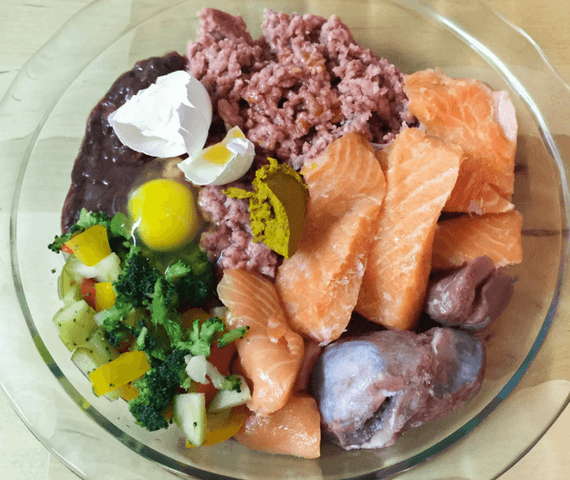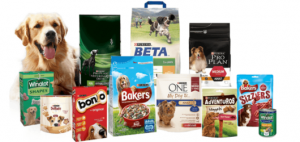Raw Based Dog Food is a controversial topic, which is increasingly trending, yet not new at all. In 1933, the Australian veterinarian Ian Billinghurst became somehow the godfather of what he called BARF. This late stands for Biologically Appropriate Raw Food, which emphasizes raw meat, bones, fruits, and vegetables.
Table of Contents
History of Raw Based Dog Food
The publishing of Billinghurst’s book,” Give Your Dog a Bone” gave voice to the dog food industry and new other types of raw dog food diets have emerged, for instance, commercial raw based dog food diets including frozen or freeze-dried dog food. In addition, other dog diets use a mix of grains, vegetables, and vitamins in addition to raw meat.
Through time, new followers embraced the Raw Food Diet. After the widespread recall of melamine-contaminated pet food in 2007, the pet food industry got a pretty strong shake, and a lot of pet owners looked for the next best choice which is Raw Based on Dog Food.
Raw dog food diet: What is it?
A raw dog food diet typically consists of:
- Muscle meat, often still on the bone
- Bones, either whole or ground
- Organ meats such as livers and kidneys
- Raw eggs
- Vegetables like broccoli, spinach, and celery
- Apples or other fruit
- Some dairy, such as yogurt
Some Raw Dog Food Diets contain compliments like yogurt or cheese or any dietary products, in addition to some enzymes or vitamins.
According to Dogs First, The ratio can vary up to 8:1:1 where the 8 refers to meat, 1 part organ meat, and 1 part bone (on the basis that this is roughly what a rat or rabbit is made of, it’s called the Prey Model). However, we find a little more organ meat is beneficial.
According to Dr. Cathy Alinovi, Ideally, a raw diet consists of uncooked meat plus what Alinovi calls additive.
“The additives range from bone to organ meat to vegetables and supplements,” Alinovi says. In addition, raw diets can also include some cooked grains or veggies. “And many people combine freeze dried dog food products (base mixes of veggies, vitamins, and minerals) with raw meats,” explains Morgan.
The most famous example for RBDF is BARF (Biologically Active Raw Food), a diet pioneered by Dr. Ian Billinghurst. According to Alinovi, a BARF-based meat patty is 50% raw meat, with an assortment of additions making up the other 50% of the ingredients.
How To Make Raw Dog Food?
Raw Based Dog Food tends to simulate wild hunted prey. Thus, providing dogs with different meat sources like organs, lean muscle meat, and bones. The vegetables and the fruits provide an extra source of vitamins, for instance, vitamin C found in tomatoes.
Raw Based Dog Food is both homemade and commercially available. Some brands like BARF Dog Food or Dr. Harvey’s Oracle Dog Food are examples of raw dog food brands. In addition, pet owners are making their own homemade raw dog food, especially with the availability of tools like; small containers, meat grinders, and the availability of raw dog food recipes online and in books.
Speaking financially, raw Based Dog Food can be both cheap and expensive. the cost of a raw dog food diet varies with the ingredients used. Usually, the meat and organs are what sets the cost of the food. According to web.md, For a 30-pound dog, a one-day supply of one variety of a frozen, commercially available raw chicken diet costs about $2.50; others may range up to $5 a day.
Why you Should Feed Your Canine Raw Based Dog Food?
According to many dog owners that fed their dogs Raw Based Dog Food, their dogs became much healthier. They say that their dogs became more energetic, playful, and even better looking. . Main noticeable changes are:
- Shinier coats
- Healthier skin
- Cleaner teeth
- Higher energy levels
- Smaller stools
Other improvements are linked with different dog brands. For instance weight changes are more noticeable with obese dogs than slim dogs.
Doug Knueven, DVM, of the Beaver Animal Clinic in Beaver, Pa, says that “Raw Based Dog Food is more beneficial than processed foods, for most animals”. Knueven who is known to defend Raw Based Dog Food explains how bacteria found in raw meat is not that big of a deal saying that the whole concern about bad bacteria is overblown.
Knueven adds that when people are Raw Feeding their dogs they know it’s not sterile, and they’re more careful about washing their hands. Knueven insists on washing both hands and tools, like counter, knives, and containers, suggesting that this is the absolute solution to avoid contamination.
Why you shouldn’t Feed Your Canine Raw Based Dog Food?
Just like benefits, Raw Based Dog Food has its potential risks for both animals and humans. Lisa M. Freeman, DVM, Ph.D., says that “many dog owners are choosing raw diets based on online myths and scare tactics about commercial pet food”. In addition, Freeman, a nutrition professor at the Cummings School of Veterinary Medicine, says that many of the benefits attributed to a raw food diet for dogs, such as a shinier coat, instead are the result of the high-fat composition of the typical raw diet. High-fat commercial foods that would produce the same effect are available, she notes, without the risk of an unbalanced diet. Supplements can also be used as an alternative to increased fat in the diet”. the main three risks that we will discuss in this post are:
1• Threats to human and dog health from bacteria in raw meat:
Studies of raw pet food have shown bacterial contamination. The FDA issued suggestions in 2004 for manufacturing raw pet food more safely, citing concern about the possibility of health risks to owners from handling the meat. A 2006 study of 20 commercially available raw meat diets found that 7.1% contained a type of salmonella. E. coli bacteria was found in 59.6% of raw meat diets. These bacteria can also be shed in the feces, leading to a potential source of human exposure and infection.
Jennifer Larsen, a clinical nutritionist at the University of California Veterinary School in Davis says“We do not recommend the feeding of raw animal products (meat, egg, bone, etc), and these types of diets are not allowed in the Veterinary Medical Teaching Hospital per our Infectious Disease Control Policy.
2• An unbalanced diet that may damage the health of dogs if given for an extended period:
Joseph Wakshlag, DVM, Ph.D., has seen those problems appear in some dogs as poor coats, bad skin, or weak bones. Too little fat means a bad coat, but too much fat and not enough protein can cause mild anemia, says Wakshlag, an assistant professor of clinical nutrition at Cornell University College of Veterinary Medicine.
Wakshlag — who accepts some research funding from Nestle Purina PetCare — says homemade raw diets also may lack enough calcium and phosphorous, causing bone fractures and dental problems. Depending on the quality of the diet, the calcium or phosphorus may also be difficult to properly digest, even if present in adequate amounts.
In addition, The FDA guidance document also suggested that manufacturers address typical nutrition problems in a raw-meat diet, including making sure it contained enough calcium and phosphorous, important for bone health. Raw-meat diets high in the liver also may supply too much vitamin A, which can lead to vitamin A toxicity if fed for an extended period.
3• Potential for whole bones to choke an animal, break teeth or cause an internal puncture
A portion of Raw Based Dog Diets is based on bones to make for calcium, however, bones being tough especially bones from big animals like cows can pose a shocking hazard. Furthermore, young dogs’ teeth are quite fragile and may break because of showing tough bones.
4• dogs are carnivores and can’t digest vegetables
Dogs being carnivores have no need for vegetables or fruits. few components of fruits or vegetables can be digested by dogs so, it’s kinda worthless. Even though some fruits and vegetables can be digested by dogs, it’s not always the case. people think that a raw diet consists of uncooked meals. In reality, though, it’s a bit more complicated than that. “Some pet owners consider throwing a pound of raw hamburger in the bowl as being a raw diet,” says Dr. Judy Morgan, DVM, a dog diet needs more than that.
5• Not suitable for dogs with pancreatitis or health problems
Just like humans, dogs can have chronic diseases and health problems. Some, if not all of them need special changes in their diets. Thanks to science, we can control what food elements to eliminate from the diet, which is hard to do with RBDF.
Even veterinarians like Knueven who support raw dog food diets say that they’re not appropriate for all dogs. Because the diets are typically high in protein, they aren’t appropriate for dogs with late-stage kidney or severe liver failure. We suggest seeing our article low protein dog food
He recommends that dogs with pancreatitis or other digestive issues start with a cooked, homemade diet and clear up problems before switching to raw. Dogs with cancer, on chemotherapy, or dogs with other immunosuppressive diseases also should not eat raw food. And puppies aren’t good candidates, either. Check out our top 25 best puppy food brands
So, what is the better choice, Raw Based Dog Food Diets, or Dry Kibble? Well, we don’t influence readers’ choices, however, we provide them with all the possible choices. In case you are more interested in raw diets and foods dogs can eat, check out the following posts:
- Ultimate Raw Dogs Diet; How to switch your dog to kibble
- Can Dogs Eat; seafood, tuna, lobster, peanuts and peanut butter, watermelon, grapes, apples, strawberries, tomatoes, eggs and cheese, each in a detailed post.
In case you were more interested in Kibble or wet dog food, check out the following posts:
- Top 10 Best Canned Dog Food Brands for 2018. (Consumer Rated)
- Top 15 Best Dog Food Brands for 2018. (Consumer Rated).
If your dog had a health problem or a chronic disease, we advise you to check out the following posts:
- low protein Dog Foods; are they good or bad?
- Top 7 Best Low Protein Dog Foods for 2018. (Kidney or liver problems)
- Top 10 Diabetic Dog Food Brands for 2018, (consumer rated)
- Top 5 Best Low Fat Dog Foods (overweight and dogs with pancreatitis)
Whatever was your choice (raw-based dog food)or cooked kibble, make sure to follow the appropriate serving procedures and make sure you and your pet are safe.



